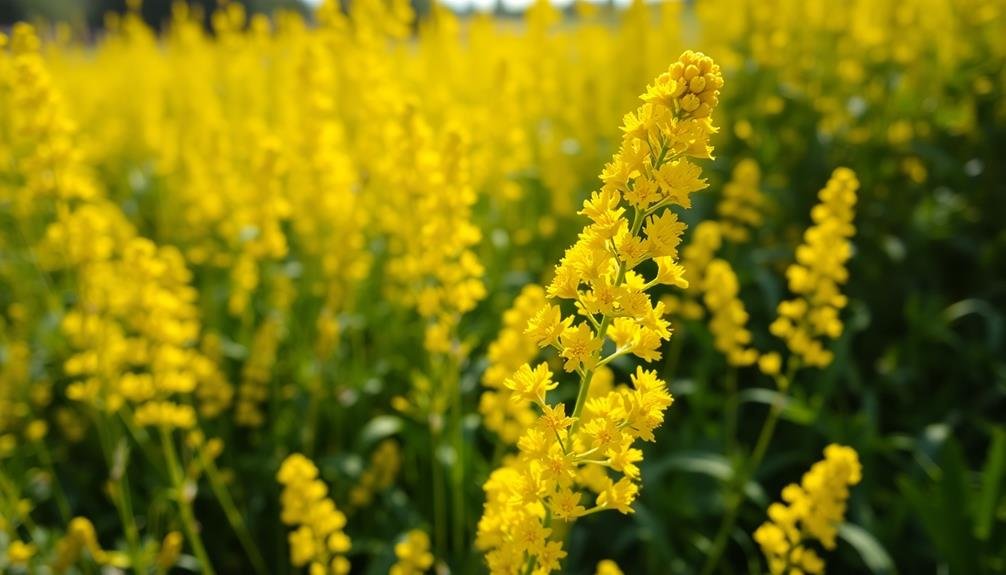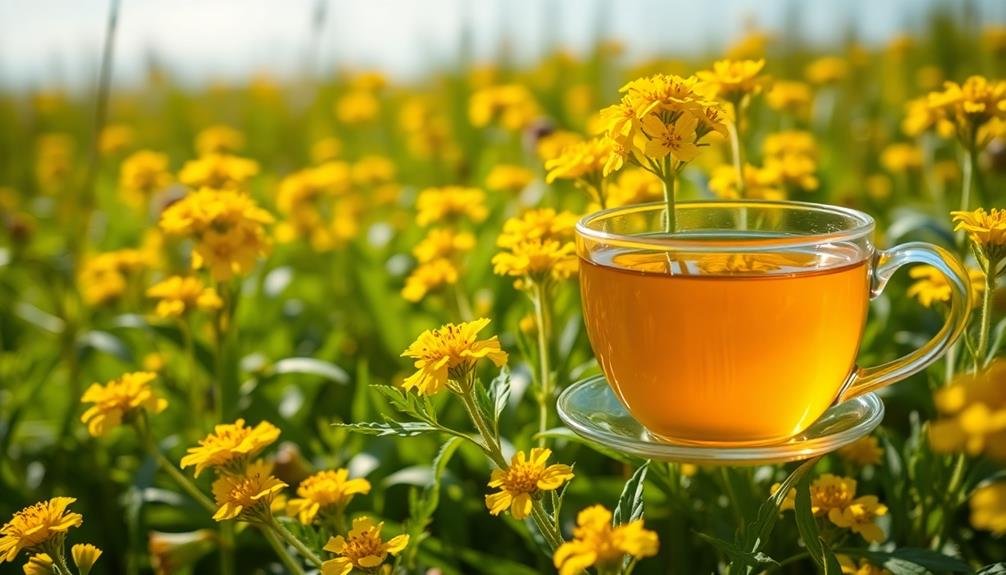Harvesting goldenrod for your herbal tea blends gives you a delightful mix of flavor and impressive health benefits. This vibrant plant is rich in antioxidants, acts as a natural diuretic, and can even help alleviate inflammation. You'll find its light, sweet floral notes add depth to your blends, pairing perfectly with other herbs like chamomile or citrus fruits. Plus, harvesting goldenrod sustainably allows you to enjoy its benefits while protecting the environment. If you're curious about how to identify and prepare goldenrod, you're in for some exciting discoverers ahead!
Benefits of Goldenrod

Goldenrod offers a range of health benefits that make it a valuable addition to your herbal tea collection. When you brew a cup of goldenrod tea, you're not just enjoying a flavorful drink; you're also tapping into its natural properties. This herb is known for its anti-inflammatory effects, which can help soothe conditions like arthritis and muscle pain.
You might find that goldenrod also supports your urinary health. It acts as a diuretic, promoting urine flow and helping to flush out toxins from your body. This can be particularly beneficial if you're looking to maintain kidney health or alleviate mild urinary tract discomfort.
Additionally, goldenrod is rich in antioxidants, which combat oxidative stress and may reduce the risk of chronic diseases. If you're feeling under the weather, goldenrod can also boost your immune system, helping you recover faster.
Incorporating goldenrod into your tea routine not only enhances your beverage variety but also introduces a plethora of potential health benefits.
Identifying Goldenrod in the Wild
When wandering through meadows or along roadside edges, keep an eye out for the vibrant yellow flowers of goldenrod. You'll often spot these plants blooming from late summer to early fall, typically between August and October.
Goldenrod can grow up to three feet tall, featuring tall, slender stems covered with clusters of small, bright yellow blooms.
To identify goldenrod, look for its distinctive leaves. They're usually lance-shaped, with a toothed margin, and grow alternately along the stem. The plant often has a bushy appearance due to the numerous flower clusters at the top.
Goldenrod's height and dense flower heads can make it stand out in its surroundings, so you won't easily miss it.
Be mindful that there are several species of goldenrod, but they generally share similar features, making identification easier.
Check for a sweet, slightly resinous aroma when you crush the leaves; this scent is a good indicator that you've found goldenrod.
As you explore the wild, remember to keep a field guide handy or take pictures to help you confidently identify this wonderful herb.
Happy foraging!
Best Harvesting Practices

When you're ready to harvest goldenrod, timing is key for the best flavor and potency.
You'll want to gather the right tools and use techniques that guarantee both quality and sustainability.
Let's explore how to make the most of your harvest while protecting this valuable plant.
Optimal Timing for Harvest
To guarantee the best flavor and medicinal properties, harvesting goldenrod at the right time is crucial. The ideal time for harvesting is during the flowering stage, typically late summer to early fall. At this point, the plant's essential oils and active compounds reach their peak concentration, making your herbal tea blends more potent and flavorful.
Here are some key indicators to help you decide when to harvest:
- Flowering Phase: Look for bright yellow blooms fully open; this shows the plant is at its prime.
- Time of Day: Harvest in the morning after the dew has dried, as this minimizes moisture content and preserves flavor.
- Weather Conditions: Choose dry, sunny days to avoid collecting excess moisture that can lead to mold during drying.
- Plant Health: Select healthy plants without signs of disease or pest damage to guarantee quality.
- Personal Preference: If you want a stronger flavor, consider harvesting just before the flowers fully open.
Tools and Techniques Needed
Having the right tools and techniques can considerably enhance your goldenrod harvesting experience. First, grab a pair of sharp garden scissors or shears; these will help you make clean cuts without damaging the plant. You'll also want to have a sturdy basket or cloth bag on hand to collect your goldenrod. This keeps the flowers intact and prevents bruising.
When you're ready to harvest, wear gloves to protect your hands from any potential skin irritants. It's also a good idea to wear long sleeves, especially if you're working in a dense patch of goldenrod.
To maximize your yield, focus on cutting the flowering tops, as these contain the most beneficial compounds for your tea. Techniques matter too—cut at a 45-degree angle to promote better air circulation for the remaining plant.
After cutting, give your goldenrod a gentle shake to remove any insects or debris. Finally, remember to work in the morning after the dew has dried but before the heat of the day sets in. This timing helps preserve the essential oils and flavor in your goldenrod, ensuring a delightful addition to your herbal tea blends.
Sustainable Harvesting Methods
Sustainable harvesting methods are vital for guaranteeing that goldenrod continues to thrive in its natural habitat. When you gather this vibrant herb for your tea blends, it's important to adopt best practices that promote its health and longevity.
Here are some key tips to keep in mind:
- Harvest selectively: Only take a few stems from each plant, allowing it to regenerate and flourish.
- Choose the right time: Pick goldenrod when it's in full bloom, typically late summer to early fall, to guarantee maximum potency and flavor.
- Use proper tools: Sharp scissors or pruning shears minimize damage to the plant, making the process cleaner and more efficient.
- Avoid overharvesting: Be mindful of the overall plant population in your area. If goldenrod is scarce, consider postponing your harvest.
- Leave some flowers behind: Allowing some blooms to remain guarantees that pollinators can access food sources and helps the plants reproduce.
Preparing Goldenrod for Tea
Preparing goldenrod for tea is a straightforward process that begins with selecting the right parts of the plant. Focus on the flowers and leaves, as these provide the most flavor and beneficial properties. Ideally, you'll want to harvest them when they're in full bloom, usually from late summer to early fall. Make sure to pick the vibrant yellow flowers and healthy green leaves, avoiding any discolored or wilted parts.
Once you've gathered your goldenrod, rinse the flowers and leaves gently under cool water to remove any dirt or insects. After washing, shake off excess water and lay the plant parts on a clean towel to dry.
You can either use them fresh or dry them for later use. If you choose to dry them, spread the goldenrod in a single layer on a drying rack or a clean, breathable surface in a cool, dark place, allowing them to air dry for several days until they're crisp.
Flavor Profiles of Goldenrod

When you brew goldenrod tea, you'll notice its unique aroma and subtle taste notes that can enhance your experience.
The floral and earthy flavors pair wonderfully with other herbs and spices, making it a versatile addition to your culinary creations.
Let's explore how to best enjoy its distinctive profile in your tea and cooking.
Aroma and Taste Notes
Goldenrod's aroma and taste are surprisingly delightful, offering a unique blend of floral and herbaceous notes that can elevate your herbal tea experience. When you brew goldenrod, you'll notice its gentle sweetness mingling with earthy undertones, creating a soothing cup that warms both body and soul. This multifaceted flavor profile makes it an excellent addition to various tea blends.
Here are some key aroma and taste notes you can expect:
- Floral: A light, sweet scent reminiscent of blooming flowers.
- Herbaceous: Subtle green notes that provide depth and complexity.
- Earthy: A grounding quality that balances the sweetness.
- Slightly Bitter: A hint of bitterness that can enhance the overall flavor.
- Warm Spices: Occasionally, you may detect a hint of warmth akin to mild spices.
These elements combine to create a harmonious experience in your cup. As you sip your goldenrod tea, you'll appreciate the way these flavors interlace, inviting you to savor each moment.
Whether enjoyed alone or as part of a blend, goldenrod's aroma and taste are sure to delight your senses.
Culinary Pairing Suggestions
To truly appreciate the unique flavor profile of goldenrod, consider pairing it with complementary ingredients that enhance its floral and earthy notes. This herb's delicate sweetness works wonderfully with bright citrus fruits like lemon and orange. Their zesty acidity can uplift goldenrod's subtle flavor, creating a revitalizing herbal tea.
You might also explore adding spices such as ginger or cinnamon. These spices not only provide warmth but also balance goldenrod's floral essence with their bold, aromatic qualities. If you prefer a sweeter blend, try incorporating honey or agave syrup, which can enhance the natural sweetness of goldenrod without overpowering it.
For a more savory twist, consider mixing goldenrod with other herbs like mint or lemongrass. These combinations can create a rejuvenating brew that's perfect for summer sipping.
Additionally, if you enjoy floral teas, blending goldenrod with chamomile or lavender can yield a soothing experience that calms the senses.
Experimenting with these ingredients will help you discover the perfect balance for your goldenrod tea blend, making each cup a delightful and nourishing experience.
Combining Goldenrod With Other Herbs
Combining goldenrod with other herbs can enhance its flavor and therapeutic benefits, creating a more complex and enjoyable herbal tea.
When you experiment with different herbs, you'll discover unique blends that cater to your taste preferences and wellness goals.
Here are some excellent herbs to pair with goldenrod:
- Peppermint: Adds a invigorating zing and can help with digestion.
- Chamomile: Brings a calming effect, perfect for relaxation.
- Lemon Balm: Offers a citrusy note and aids in reducing stress.
- Hibiscus: Introduces a tart flavor and boosts vitamin C content.
- Echinacea: Enhances immune support, making it a great choice during cold season.
Health Benefits of Goldenrod Tea

While you might enjoy the rich flavor of goldenrod tea, its health benefits are just as significant. This herbal infusion is packed with antioxidants, which help combat free radicals in your body. By sipping goldenrod tea, you can support your immune system, making it easier to fend off illnesses.
Goldenrod has natural diuretic properties, meaning it can help promote urination and support kidney function. If you're looking to flush out toxins or reduce water retention, this tea can be a great addition to your routine.
Additionally, it's known to help soothe digestive issues, easing bloating and discomfort. People often turn to goldenrod tea for its anti-inflammatory benefits as well. If you struggle with conditions like arthritis or general aches, this tea may provide some relief.
Furthermore, it's believed that goldenrod can help alleviate seasonal allergies by reducing inflammation in your respiratory system. Incorporating goldenrod tea into your daily habits can offer a range of health benefits.
You'll not only enjoy its distinct flavor but also harness its potential to enhance your overall well-being. So, why not brew a cup and experience its advantages for yourself?
Sustainability in Foraging Goldenrod
When you forage goldenrod, it's essential to do so sustainably to protect the plant and its ecosystem. This resilient plant plays a significant role in supporting local wildlife and maintaining biodiversity.
By following sustainable foraging practices, you guarantee that goldenrod remains abundant for future generations.
Here are some tips to forage goldenrod responsibly:
- Harvest selectively: Only take a few stems from each plant, leaving enough for pollinators and the ecosystem.
- Avoid overharvesting: Limit your collection to what you need, allowing the plant to thrive and reproduce.
- Know your location: Forage in areas where goldenrod grows abundantly, and steer clear of protected or endangered habitats.
- Practice seasonal foraging: Harvest during peak blooming times, typically late summer to early fall, to minimize stress on the plant.
- Educate yourself: Learn about local regulations and the specific species of goldenrod in your area to guarantee you're foraging ethically.
Frequently Asked Questions
Can Goldenrod Be Used in Herbal Remedies Besides Tea?
Yes, you can use goldenrod in various herbal remedies besides tea. It's great for tinctures, poultices, and infused oils, helping with inflammation, allergies, and urinary issues. Get creative with your herbal preparations!
What Time of Year Is Best for Harvesting Goldenrod?
You'll want to harvest goldenrod in late summer to early fall, when the flowers are fully bloomed. This timing guarantees you're collecting the most potent parts, maximizing the benefits for your herbal preparations.
How Do I Store Harvested Goldenrod for Later Use?
After harvesting goldenrod, you should dry the leaves and flowers in a cool, dark place. Once fully dried, store them in airtight containers, away from light and moisture, to preserve their flavor and potency for later use.
Are There Any Safety Concerns When Consuming Goldenrod?
When consuming goldenrod, you should be cautious if you're allergic to plants in the Asteraceae family. It's best to consult a healthcare professional if you're pregnant or taking medications, just to be safe.
Can Goldenrod Be Cultivated in My Garden?
Yes, you can cultivate goldenrod in your garden. It's a hardy perennial that thrives in various soil types and conditions. Just guarantee it has enough sunlight, and it'll flourish beautifully, attracting beneficial pollinators.
In Summary
Harvesting goldenrod for your herbal tea blends brings a wealth of benefits, from its unique flavor to its impressive health properties. By identifying, foraging sustainably, and preparing it thoughtfully, you can enhance your tea experience. Don't forget to experiment with combining goldenrod with other herbs to create delightful blends. Embrace the natural world around you, and let goldenrod elevate your herbal tea journey—it's a simple, rewarding way to connect with nature and boost your well-being!





Leave a Reply